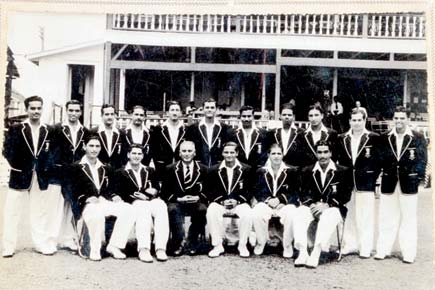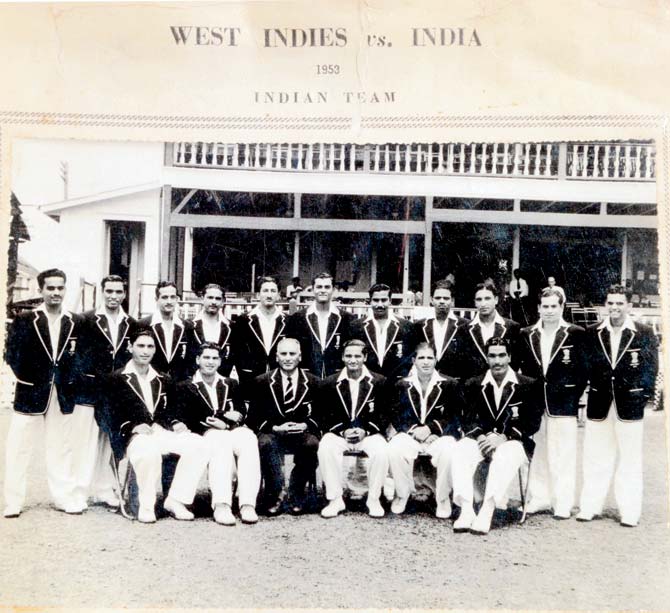With Virat Kohli & Co now in the West Indies for a four-Test rubber, we look back to India’s historic first tour of the Caribbean in 1953

 Yesterday, Virat Kohli & Co became the 11th Indian Test team to land in the Caribbean. The journey was by no means short, but nothing in comparison to India’s first ever visit to the West Indies.
Yesterday, Virat Kohli & Co became the 11th Indian Test team to land in the Caribbean. The journey was by no means short, but nothing in comparison to India’s first ever visit to the West Indies.
For Vijay Hazare’s 1952-53 tourists, a Bombay-London flight on Christmas Eve was followed by a near-fortnight ship journey from Southampton to Trinidad on what Mumbai-based former opening batsman Madhav Apte, the baby of the team, called a banana boat.
ADVERTISEMENT

The Indian team which toured WI in 1953. Pic/Deepak Shodhan personal collection
“I say banana boat because the SS Golfito carried bananas from the West Indies to Europe and it returned empty which is why it rocked so much,” Apte told me with a chuckle.
Some of the players got seasick. One day, as Apte recounted in his autobiography As Luck Would Have It, premier all-rounder Vinoo Mankad, who was sharing a cabin with him, experienced extreme shivering and body ache. Apte wrapped Mankad — his coach at Elphinstone College — with five blankets and two kit bags but to no avail.
When the team reached Trinidad, the locals never stopped extending dinner invitations, conveniently forgetting that the Indians were there to play cricket and perform with distinction for their country, which they did, to find good space in the company of other proficient Indian teams to tour the West Indies.
Ajit Wadekar’s 1971 tourists will remain most celebrated because the side earned India its first ever Test, leave alone series win in the Caribbean. Of course, Bishan Singh Bedi’s team which chased a world record 403 runs in the fourth innings of the 1976 Trinidad Test, was an accomplished outfit too and so was Rahul Dravid’s 2006 side which became only the second Indian team to win a Test series in the West Indies. MS Dhoni & Co won in 2011, but their triumph was not as impressive.
The 1952-53 team has not earned enough credit. They played five Tests and West Indies, under Jeff Stollmeyer, could win only one of them — the second Test at Barbados where the hosts won by 142 runs.
Hazare’s team were up against formidable opponents, but his team was no less big-named — Vinoo Mankad, Pankaj Roy, Dattu Phadkar, Vijay Manjrekar, Polly Umrigar, GS Ramchand and Subhash Gupte. But the surprise package came in the form of Apte, who scored 460 runs.
Politics and groupism have always been part of cricket — more then than now — but captain Hazare in his book Cricket Replayed, wrote: “I consider this as my best tour. There were no factions in the side and our boys conducted themselves with dignity.”
It was on this tour that Gupte met his future wife Carol in San Fernando and bliss was coupled with Test scalps — 27 of them — against batmen of the calibre of Everton Weekes, Frank Worrell and Clyde Walcott. Tony Cozier, the West Indies encyclopedia who passed away recently, wrote in West Indies: Fifty Years of Test Cricket: “The abiding memory of the tour is of the little Indian leg-spinner Subhash Gupte flighting the ball temptingly, the West Indian batsmen, principally the vivacious Weekes, stepping out to drive him powerfully and the fielders, many bedecked in large pith helmets, swooping on the ball and throwing it back to the wicketkeeper with speed and precision. It was engrossing cricket.”
Two of those fielders had to be CV Gadkari, who scored an unbeaten 50 in the Georgetown Test and DK Gaekwad dislocated his shoulder while going for a catch.
Weekes, who continued his incredible run-making streak against the Indians from the 1948-49 series, paid the Indian fielding side a fine tribute in his book Mastering the Craft, in which he wrote: “The Indians were not the best bowling side in the world, but they arguably were the best fielding side.” Of Gupte, he stressed, “He was a master spinner; there was no doubt about that; and he did embarrass many of our chaps who tried to use their feet.”
Garfield Sobers, yet to be capped a Test player then, had his first sighting of Gupte, whom he went on to rate a better spinner than Shane Warne.
If Apte was the batting find of the tour, Umrigar topped the run charts with 560 aided by two centuries — a far cry to his 43 in four Tests during the England tour the previous year.
The Indians could also boast of grit and bravado. Deepak Shodhan, who lost his place in the team after a 45 in the opening Test at Trinidad, made a comeback in the final Test at Kingston. He was too ill to bat in the first innings, but, according to Apte, came out from his hospital bed to help India save the Test with his unbeaten 15. That was his last Test innings.
Before the 1952-53 Indians, only England had visited the West Indies for a Test series so it was a historic tour in more ways than one. The sad part is that all but two members of that India squad are deceased. The good news is that the two survivors — Apte and Gaekwad — can still watch and appreciate the talent and ability of the current tourists.
mid-day’s group sports editor Clayton Murzello is a purist with an open stance. He tweets @ClaytonMurzello. Send your feedback to mailbag@mid-day.com
 Subscribe today by clicking the link and stay updated with the latest news!" Click here!
Subscribe today by clicking the link and stay updated with the latest news!" Click here!







